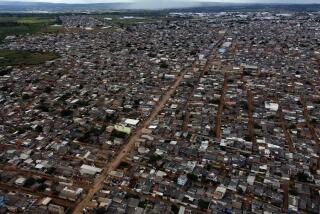Potholed Streets, Shantytowns Common Sights : 11 Years of War Taking Toll on Angola
- Share via
LUANDA, Angola — Angolans have been at war for 11 years, and the strain is showing.
The streets of this once-handsome Portuguese colonial outpost are potholed and neglected. Open drains flow past mounds of refuse as big as houses. Small boys carefully sift through the garbage for anything that can be eaten or sold.
In a city center square, a captured armored car on a concrete pedestal celebrates--somewhat prematurely--the victory of the Marxist Popular Movement for the Liberation of Angola (MPLA) in the civil war against the National Union for the Total Independence of Angola (UNITA) forces of Jonas Savimbi that followed the end of 400 years of Portuguese rule in 1975.
More than a decade later, South African arms and supplies have helped UNITA establish control over much of south and east Angola. Annual offensives by the Angolan army, called FAPLA, reinforced with Soviet arms and 20,000 or more Cuban troops, have petered out in the sands and scrub of Savimbi’s well-defended base area around Jamba.
The U.S. decision earlier this year to arm Savimbi with Stinger anti-aircraft missiles may further entrench the stalemate.
Money From Oil
Yet, while the war goes on in the rest of the country, representatives of American capitalism and Soviet communism cohabit peacefully in Luanda.
Cabinda Gulf, a subsidiary of the U.S. oil giant Chevron, has developed the oil-rich Cabinda enclave on Angola’s northern coast into a $1.3-billion investment. Oil revenue provides more than 90% of the government’s income.
Without the annual payments by Chevron and companies such as Conoco and Texaco, the government would have to revise its defense priorities. Defense currently consumes 38% of the annual budget--officially. Others estimate that the war effort consumes up to 60% of government income.
Sources in Luanda say the Soviet Union is constructing a military and naval base in Aoyo district, just across the Zaire River from Cabinda, to counter the growing UNITA threat to the oil installations that pump Angola’s lifeblood.
Nowhere is the war effort more obvious than at the airport.
Under the stern glare of a giant painting of Dr. Agostinho Neto, the MPLA founder and first president of Angola who died in September, 1979, Soviet transport planes disgorge upward of 10 cargoes of war materiel a day. MIG-23 fighters, piloted by Soviet-trained Angolans, take off on regular “search-and-destroy” missions against UNITA.
As the war drags on, Luanda seems to be disintegrating visibly.
Shantytowns Common
The city put on a brave face for the recent summit meetings of the African front-line states and the nine-member Southern African Development Coordination Conference. However, on their drive from the airport to the president’s beachfront complex, heads of state passed some of Luanda’s sprawling shantytowns where more than 1 million people live.
On paper, Angola is a relatively egalitarian society. The minimum wage in Luanda is 6,000 kwanzas ($200) a month at official exchange rates. The president’s salary is only 40,000 kwanza ($1,300) a month.
The MPLA party is still a privileged elite of only 37,000 members in a population of more than 7 million. At independence, few Angolans were educated or even literate, and the colonial structure of privilege has proved difficult to overcome.
More to Read
Sign up for Essential California
The most important California stories and recommendations in your inbox every morning.
You may occasionally receive promotional content from the Los Angeles Times.












